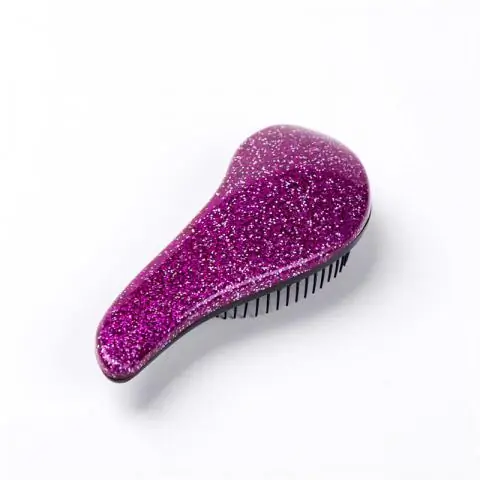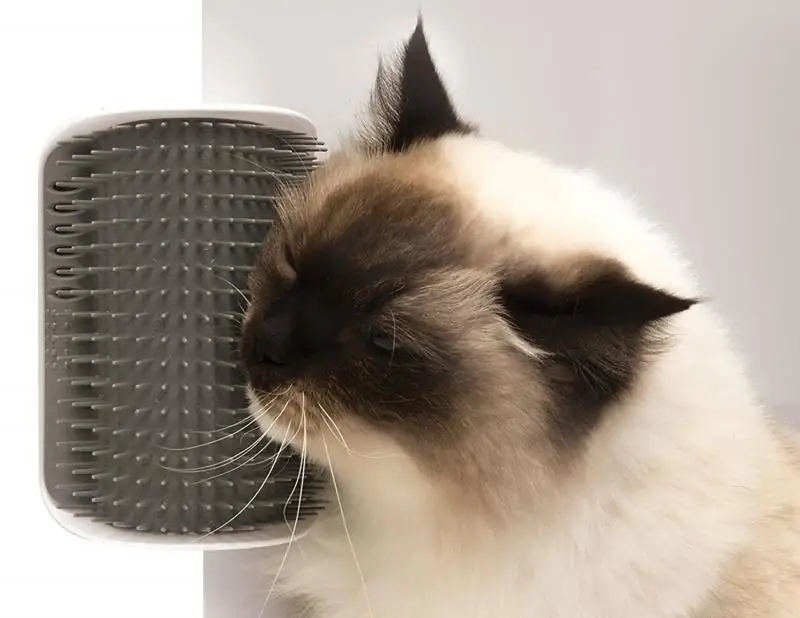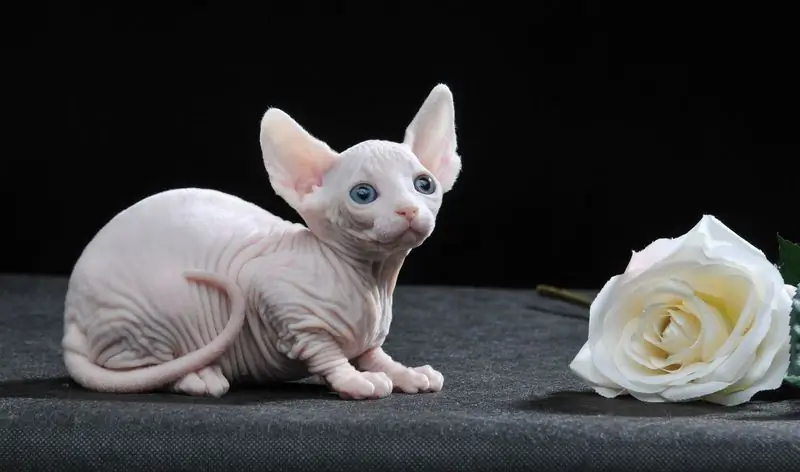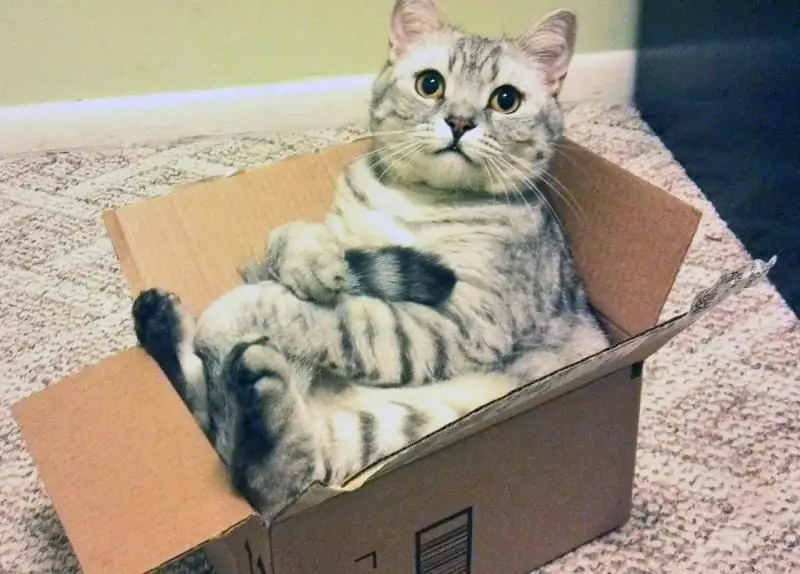
Table of contents:
- Author Bailey Albertson [email protected].
- Public 2023-12-17 12:53.
- Last modified 2025-01-23 12:41.
Cat tangles: how to prevent tangling

Almost all cat breeds boast a fluffy coat. It's always nice to touch the soft coat and pet your pet. But this is not only a pleasure and delight for the eyes, the coat requires constant care, because it is regularly updated, not to mention the shedding periods. Every owner is faced with the need to choose a product for caring for his cat, and the most important tool in this beauty arsenal is a hair comb.
Content
- 1 Mats in cats and their danger
-
2 Cat Hair Grooming Accessories
- 2.1 Comb-slicker
- 2.2 Koltunorez
- 2.3 Cat brushing mitt
- 2.4 Brush-comb
- 2.5 Furminator
- 2.6 Combs
- 3 How to use a cat clipper
- 4 Prevention of mats
- 5 Cat owner reviews
Mats in cats and their danger
Hair in cats grows constantly, completely renewing itself during shedding - the period of natural change of the coat, when the number of hairs at rest reaches 90%. The rest of the time, the ratio of growing hair in the stage of active development and already "dead" in the resting stage is about 50 to 50. The hairs are renewed regularly, those that have passed into the resting stage fall out and no longer grow.
Given the density of the animal's fur coat, it is not surprising that naturally lost hairs can get stuck in neighboring ones and get tangled. This is a normal phenomenon for absolutely any fluffy cats, therefore it is recommended to comb them daily to help the already torn hairs leave the pet's body. If this is not done, the wool will begin to get tangled, clump and form tangles - dense matted areas that resemble felt.

Mats are formed due to entanglement of falling hairs and still alive, straying into dense lumps
In addition to the natural process of hair felting as a result of lack of grooming, mats can appear for other reasons, due to which the quality of the wool cover decreases and more active hair loss occurs:
- metabolic disorders in the animal body;
- the appearance of dandruff, which leads to tighter bonding of hairballs;
- using hair cosmetics that are not intended for cats;
- improper washing, too active rubbing in soap compositions and aggressive combing of wet wool;
- infestation with ectoparasites (fleas);
- contamination on the coat that the cat itself cannot remove - glue, oil, fuel oil, caramel, etc.
Most often, tangles are formed in places of greatest friction - on the neck, under the paws, behind the ears, on the tail, that is, in those areas that are constantly in motion. Broken hair is both an aesthetic problem and a real threat to your pet's health. At first glance, matted wool is harmless, but if there are a lot of tangles and they are dense, then this turns out to be:
- pain when moving - in whom not only the fallen hairs get lost, but also healthy ones that break out, pull the skin, causing significant pain;
- the appearance of severe irritation - the cat will strive to get rid of discomfort, therefore, attempts to gnaw or remove the mats with claws is an expected phenomenon, due to which irritation will appear, the pet can pull out the mats along with healthy hairs, resulting in injuries to the integument;
- rotting of the skin - dense and large mats, close to the skin, disrupt thermoregulation, the pet begins to suffer from inflammation, ulcers, the development of infection in a humid and warm environment favorable for this;
- by the reproduction of ectoparasites - fleas are very difficult to remove if there is such a favorable environment for them as loose wool.

The mats gradually grow, and without receiving help, the animal may be captured by its own wool.
Obviously, you should not start the state of your domestic predator and bring the coat to a critical point, you need to pay attention to grooming and brushing daily.
Cat Hair Grooming Accessories
The basis of high-quality hair care for a cat is the regular removal of lost hairs from the body, for which special combs are used.
Comb-slicker
The slicker is the most popular tool for combing wool. The device looks like a comb with a rectangular or square head, on which there are numerous thin teeth bent to one side approximately in the middle. The bristles themselves are bound to be metallic. Such combs are relevant for long-haired and semi-long-haired breeds of cats - the slicker is used to remove the undercoat and fluff up the fur, including on the tail. It is recommended to use the slicker not every day, as it removes the undercoat rather aggressively, and the teeth are sharp and can irritate the skin. This type of comb can be used 2-3 times a week during shedding, and once a week at normal times.

A slicker, or slicker, is a tool for removing the falling out undercoat, which allows you to fluff the coat well
When choosing, you need to rely on the quality of the coat - the thicker and longer the pet's coat, the more frequent and long the bristles of the combs should be. It is quite simple to use the slicker, with rather careful movements without pressure, comb the coat according to its growth to remove the fallen hairs. If we are talking about Persian cats, then they can fluff up the coat, moving against its growth. In the process, you need to periodically remove the collected hairs from the bristles - when they accumulate on the comb, they interfere with combing new ones. Such a device is not suitable for combing out tangles - the result can be achieved, but the process will be painful and traumatic.
Koltunorez
The koltunorez will be useful to the owner of the cat if tangles have already formed on the wool and it is necessary to remove them painlessly. Any such device is a set of safety blades attached to one base. There are several types:
-
Vertical collar cutter. Outwardly, this look resembles an ordinary cat comb, but instead of standard teeth, the comb has blades that are rounded at the end. Their number can vary from 4 to 12 pieces, the length of the teeth can also be different.

Vertical collar cutter A vertical collar cutter is similar to a comb, which has blades instead of teeth
-
Horizontal - the blades on it are located perpendicular to the handle, like a slicker.

Horizontal collar cutter The horizontal collar cutter has teeth perpendicular to the handle
-
Drop-shaped collar cutter. On the rounded handle of such a device there is a hook, inside which the blade is hidden. This type is used to remove clumps of stray hair in hard-to-reach places, where it is simply not possible to pick up with a sharp few teeth.

Drop-shaped collar cutter Drop-shaped collar cutter is used for pinpoint removal of tangles in hard-to-reach areas
The principle of operation of the koltunorez is simple - it is brought to the koltun and pryed, trying to comb it. The blades will cut the stray lump, and after a few passes with the tool, the mats can be completely removed.
There are a number of parameters to consider when choosing a grooming device:
- Length of serrated blades. Here the relationship is simple - long hair will require long teeth and vice versa. If this parameter is not taken into account, then either the procedure will pass without the desired result, or there will be a risk of injury to the animal.
- The location of the teeth. There are no strict rules in choosing a horizontal and vertical collar cutter, here the personal preferences of the owner of the cat are of great importance. But usually for long hair it is more convenient horizontal, and for medium and short - vertical collar cutter.
- Number of teeth. Dense and large tangles are easier to remove with a wide collar cutter with a large number of blades, and for small areas a minimum option with 4 prongs will suffice.
- The quality of the materials. The best option would be high quality steel, the blades should be free from defects, smooth and hard. The presence of a rubberized coating on the handle is an additional plus, so the collar cutter will lie better in the hand and will not slip out if the palm sweats.
Having a Persian cat in my pets for more than 13 years, I am not by hearsay familiar with the problem of tangles. For a long time, it was impossible to avoid them, given that the cat did not allow itself to be scratched under its paws and on its stomach. It was possible to get rid of the problem by carefully cutting out the rolled wool with scissors, but it took a lot of time and effort. It's good that such a thing as a collar cutter caught my eye - it turned out to be much easier. In addition, when using it, there is no need to keep the animal for an unpleasant procedure for a long time.
Cat brushing mitt
A mitten for wool care looks exactly as it is called - it is a whole mitten or just a part of it, which is worn on the fingers, on the inside of which there are soft teeth, often of different lengths. This tool is indispensable during shedding - it gently captures and pulls out all dead and ready to fall hairs, additionally providing a massage effect on the skin. It is useless to use a mitten for daily combing or to deal with mats - the short and soft bristles are unable to comb the wool itself.

Combing mitt allows you to gently remove dead hairs from the fur coat
Brush-comb
Brushes for grooming hair are very similar in appearance to massage combs for humans - they have a platform, often with a soft base, on which numerous teeth are located. There are several design options:
- metal teeth (pin-brush) - used for everyday care and in the grooming process, they do an excellent job of combing out the decorating areas of long-haired and semi-long-haired cats (breasts, panties);
-
natural bristles - a universal option that is suitable for wool of any length, with the help of such a brush you can comb the animal with high quality, distribute and comb dry shampoo or powder for wool, additional advantages are the massage effect and antistatic properties, which is most important for cats with soft and thin wool;

Natural bristle brush A brush with natural bristles - a universal tool for grooming hair both at home and in grooming salons
- silicone bristles - in terms of functionality, this type of brush is similar to a mitten, the teeth pull out dead hairs.
Furminator
A furminator is a special comb, in which a blade is hidden behind a row of metal teeth. The construction is designed in such a way that the entire dead layer is easily combed off, and healthy hairs are not damaged. All you need to do is scratch the cat like a regular comb, enjoying the benefits of the tool:
- no need to choose wool from the comb by hand, it does not linger in it;
- safety both for the guard hair on the fur coat and for the pet itself;
- combing efficiency for both short-haired and long-haired breeds;
- accelerating the molting process.

Furminator - a unique grooming brush that effectively removes hair during shedding
Combs
For daily grooming, you cannot do without combs. They are of different types:
- a comb with sparse teeth - suitable for cats with any length of hair (except for very short), with its help you can unravel the stray lumps, comb the animal during or after bathing;
- a comb with fine, frequent teeth - usually small in size and is used to break loose hair in hard-to-reach places, for example, behind the ears or armpits, does an excellent job of removing dried dirt from the fur, and also helps to look for fleas, qualitatively pushing the pet's fur coat;
-
the comb with frequent thick teeth is a variant of the comb for short-haired cats, which is suitable for daily grooming;

Comb with frequent thick teeth Comb with frequent, thick teeth - an option that is suitable for short-haired cats
- a comb with teeth that rotate - this is an excellent solution for long-haired cats with soft hair, during the combing process, the teeth scroll and slide along the hairs without pulling them out, but at the same time effectively breaking the areas where the hair begins to thicken;
- comb with teeth of different lengths - this type of comb is necessary for daily care of wool with a dense, dense undercoat and long, stiff guard hairs, due to the different lengths it is possible to comb the coat at the same time at both its levels.
How to use a cat clipper
When areas of churning of wool appear, it is important to react quickly - immediately try to disassemble and comb them. If mats have already formed on the body, then it is necessary to get rid of them as soon as possible, otherwise they will only grow - this will help the koltunorez.
Cutting with scissors, which is often used to replace the purchase of a special tool, forms ugly bald spots and carries a high risk of injury to the animal, not to mention the amount of time spent. Using a collar cutter at home is the only quick way to deal with a problem with high quality.
Algorithm for working with the tool:
- Preparation. The cat must be found in a benevolent mood, calm and well-fed. It is better to ask no one to interfere and not to enter the room during the procedure, so as not to frighten or distract the animal.
- The pet must be placed on the floor, but slightly held under the belly, gently fixing it in one place.
-
Loose wool can be treated with a special product to facilitate combing:
-
spray-conditioner with mink oil from "Pchelodar";

"Pchelodar" spray conditioner Spray "Pchelodar" - a tool to facilitate combing and styling, to gently untangle tangles, prevent fragility and restore the structure of hairs
- Absolu Demelant's Absolute Tackle Punches;
- spray "Silk" from "Api-san".
-
- With a collar cutter, without pressure, you need to comb the problem area in the direction of hair growth. The movements are repeated until the mat is completely removed.
- In hard-to-reach places, it is better to use a drop-shaped collar cutter. It must be brought to the base of the mat and carefully cut off the wool with a blade motion.
Prevention of tangles
Every cat owner needs to take care of the condition of his pet and his fur coat, because the main condition for preventing the formation of tangles is regular and correct combing. To avoid the problem, you should follow these recommendations:
- comb the cat at least 1-2 times a week, and if the breed is long-haired with soft hairs, then strictly every day, this will allow timely removal of all dead hairs;
-
while washing, it is better to use not only shampoo, but also a conditioner that prevents the formation of tangles and facilitates combing, in addition, the method of applying the product to the coat is important - this should be done with stroking movements along the growth of the hairs, otherwise the wet coat will easily get tangled;

Bathing a cat When bathing your cat, it is important to use not only shampoo, but also conditioner for the coat.
- at the end of bathing, it is better to use a hair dryer - this way it is possible to control the drying process of the fur coat and comb it with high quality;
- the cat needs to be provided with adequate nutrition and sufficient supply of vitamins and minerals, metabolic disorders often lead to pathological hair loss.
During shedding, the risk of tangling is especially high, since there is a lot of hair falling out. Intensive care of the animal will help to avoid the problem: the use of special shampoos for shedding cats, daily combing, including using a furminator.
Cat owners reviews
Caring for the coat of a domestic cat is one of the main tasks of the owner. This provides not only an attractive appearance of the animal, but also has a positive effect on its health, because the formation of tangles can cause a lot of pain and discomfort. And what kind of tools to use depends on the breed of the animal and the characteristics of its wool.
Recommended:
How To Clean Hair And Dirt From A Comb At Home (massage, From Natural Bristles, Etc.)

How to clean dust, grease and other dirt from a comb. Features of care for different types of tools. Instructions and useful video
Bald Cats: Popular Breeds, Their Descriptions And Photos, How To Care For And Feed Cats, Owner Reviews

The history of the appearance of cats without hair. Bald cat breeds. Features of caring for an unusual pet. Photo, video. Reviews
A Comb For Cats: Why You Need It, Types Of Devices For Combing, How To Do It Yourself, Where It Is Convenient To Place, Tips

Does the cat need a comb. What are the types of comb. How to make a comb for a cat yourself. Photo and video instructions. How to train your cat to scratch. Reviews
Dwarf Cats And Cats: What Breed Is Recognized As The Smallest In The World, The Peculiarities Of Their Maintenance And Breeding, The Nuances Of Choosing A Pet

Dwarf cat breeds, their weight and features. Which breed is recognized as the smallest. The smallest cat in the world. Problems of dwarf breeds. Photo and video
Why Cats And Cats Love Boxes: How It Manifests Itself, What Are The Reasons, Harm And Benefits Of Such A Habit, Photos, Videos

Why cats and cats love boxes, how it manifests itself, what are the reasons for this behavior. The harm and benefits of such entertainment. What else attracts cats. Reviews
